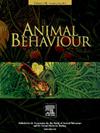一种合作繁殖的鸟类在筑巢聚集时会持续保持社会偏好
IF 2.3
2区 生物学
Q2 BEHAVIORAL SCIENCES
引用次数: 0
摘要
要了解不同类群中促进和维持动物社会性的进化途径和机制,关键是要揭示同种聚集是由真正的社会吸引还是由非社会强迫因素(如局部资源)导致的,以及社会偏好是否在不同环境中得以维持。在这里,我们发现,在合作繁殖的腐食鸦群(Corvus corone)中,核心社会单位在较高水平的聚集(巢穴)中持续存在。在我们的研究种群中,乌鸦个体常年生活在一个具有凝聚力的领地亲属群中。晚上,来自不同领地的乌鸦可能会在该地区现有的四个栖息地之一集体睡觉。通过对 73 只乌鸦进行辐射追踪,我们发现乌鸦主要在冬季以及秋季和春季的寒冷夜晚使用栖息地,这表明夜间聚集具有调节体温的功能。有趣的是,我们还发现同一社会群体的成员会优先使用同一栖息地,这表明社会凝聚力并不是仅仅通过吸引到同一栖息地而实现的,而是建立在主动选择加入群友的基础上。因此,我们的研究结果表明,合作乌鸦的社会偏好会在不同的聚居环境中持续存在,这进一步揭示了乌鸦社会的复杂性,并表明了栖息地的社会功能。然而,不同的社会群体并没有以稳定和可预测的方式在栖息地水平上合并,这为该种群的多级社会提供了微弱的支持。本文章由计算机程序翻译,如有差异,请以英文原文为准。
Social preference persists at roosting aggregations in a cooperatively breeding bird
Animal sociality ranges from predominantly solitary life to complex multilevel societies in which stable core units merge into increasingly inclusive entities.
To understand the evolutionary pathways and mechanisms that promote and maintain animal sociality in different taxa, it is crucial to uncover whether conspecific aggregations result from true social attraction or nonsocial forcing factors (e.g. localized resource) and whether social preference is maintained in different contexts. Here, we show that, in cooperatively breeding carrion crows, Corvus corone, core social units persist at higher levels of aggregations (roosts). In our study population, individuals live in cohesive territorial kin groups year-round in an all-purpose territory. At night, crows from different territories may sleep communally in one of the four roosts available in the area. By radiotracking 73 individuals, we found that roosts were used mainly in winter and on cold nights in autumn and spring, suggesting a thermoregulatory function of nocturnal aggregations. Interestingly, we also discovered that members of the same social group preferentially used the same roost, showing a social cohesion that was not achieved by mere attraction to the same roosting site but was based on an active choice of joining groupmates. Therefore, our results indicate that social preference persists in different aggregation contexts in cooperative crows, revealing a further complexity of their society and suggesting a social function of roosts. However, different social groups did not merge in a stable and predictable way at the roost level, providing weak support for a multilevel society in this population.
求助全文
通过发布文献求助,成功后即可免费获取论文全文。
去求助
来源期刊

Animal Behaviour
生物-动物学
CiteScore
4.60
自引率
8.00%
发文量
236
审稿时长
10.2 weeks
期刊介绍:
Growing interest in behavioural biology and the international reputation of Animal Behaviour prompted an expansion to monthly publication in 1989. Animal Behaviour continues to be the journal of choice for biologists, ethologists, psychologists, physiologists, and veterinarians with an interest in the subject.
 求助内容:
求助内容: 应助结果提醒方式:
应助结果提醒方式:


